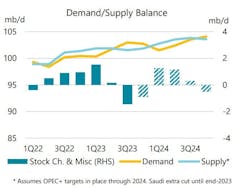IEA revises up 2023, 2024 global oil demand forecasts
In its November issue monthly Oil Market Report, the International Energy Agency (IEA) raised its global oil demand forecasts for 2023 and 2024.
IEA increased 2023's demand growth forecast to 2.4 million b/d from last month's report forecast of 2.3 million b/d.
“US deliveries proved more resilient than indicated by preliminary data and Chinese oil demand in September set another all-time high above 17 million b/d, fueled by a booming petrochemical sector,” IEA said. However, IEA noted, those gains have come to the detriment of petrochemical producers elsewhere, most notably in Europe and advanced economies in Asia and Oceania.
Next year's demand growth has also been revised to 930,000 b/d from last month's 880,000 b/d. Despite growth that is almost two-thirds lower than this year’s increase, global oil demand is set to rise to a record annual high of 102.9 million b/d in 2024. In the OECD, however, economic headwinds are increasingly apparent, with this year’s slim demand gains giving way to a contraction in 2024, according to IEA.
World oil output increased by 320,000 b/d in October to 102 million b/d. Growth in the US and Brazil is outperforming forecasts, helping to propel global supply higher by 1.7 million b/d to a record 101.8 million b/d in 2023. In 2024, non-OPEC+ producers will continue to lead global growth, projected at 1.6 million b/d, to an unprecedented 103.4 million b/d.
“Meanwhile, top oil exporters Saudi Arabia and Russia confirmed in early November they would continue with their additional voluntary output cuts until the end of the year. Those cuts look set to keep the oil market in a significant deficit through year-end, with the OPEC+ alliance pumping 900,000 b/d below the demand for its crude,” IEA said.
“With demand growth set to slow, the market could shift into surplus at the start of 2024. For now, with demand still exceeding available supplies heading into the Northern Hemisphere winter, market balances will remain vulnerable to heightened economic and geopolitical risks – and further volatility ahead.”
Meantime, IEA noted that, the war between Israel and Hamas that began in early October has not had a material impact on oil supply flows. A temporary easing of US sanctions on Venezuela in late October is expected to have only a marginal impact on supply, as production increases from the country’s battered oil sector will take time and investment.
Refining margins
Refinery margins collapsed in October from the near-record levels achieved during third-quarter 2023. The decline was primarily driven by weaker gasoline cracks, but still-elevated middle distillate cracks ensured margins remain above the 5-year average. Global crude runs are expected to rise by 1.9 million b/d in 2023 and 1 million b/d in 2024, to average 82.6 million b/d and 83.6 million b/d, respectively.
Russian oil exports
Russian oil exports eased by 70,000 b/d in October, to 7.5 million b/d, as higher crude oil shipments failed to offset a decline in product flows. Estimated export revenues fell by $25 million to $18.34 billion as lower international oil prices more than offset a narrowing discount for Russian grades versus North Sea Dated. Russian crude and product prices, apart from gasoline and vacuum gasoil (VGO), were above the G7 Price Cap.
Inventories, prices
Global observed inventories rose by 9.9 million bbl in September but remain near historical lows. Oil on water rebounded by 25.3 million bbl and OECD stocks inched up by 2.9 million bbl while non-OECD inventories declined by 18.3 million bbl. In third-quarter 2023, crude oil stocks plunged by 141.4 million bbl while oil product stocks increased 112.7 million bbl as supply cuts by OPEC+ countries coincided with increased refinery activity.
ICE Brent futures slumped by $8/bbl during October as the macroeconomic outlook deteriorated and supply fears following the Hamas attack on Israel subsided. Crude’s forward structure eased in tandem with flat prices, as contango returned to prompt WTI time spreads for the first time since July. The price rout continued into early November.
